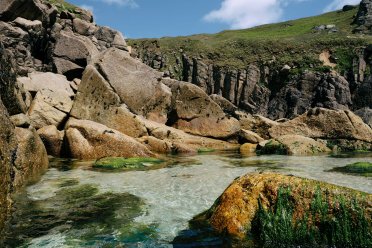Porthcurno was once an important place on the map. It was the centre of world telecommunication and, until recently, there was a training school for that industry to which people came from all over the world. The Porthcurno Telegraph Museum remains as a testament to the past. It incorporates tunnels well below the surface use to house top secret equipment during the Second World War.Porthcurno Beach is about three miles east of Land`s End on the south coast of West Cornwall. It faces south-east and lies in the western corner of lovely Porthcurno Bay. A wide footpath gently slopes down to the beach from a large car park around 200 yards above. There is a café across the road from the car park and a restaurant not far away during the in season. In the car park are public toilets and a telephone. The sandy beach shelves quite swiftly.
On the cliffs to the west of Porthcurno is the world famous Minack Theatre . This wonderful open air venue commands superb views across Porthcurno Bay, with its turquoise water and golden rocks, as far as The Lizard. Between May and September each year, performances are given by a variety of theatrical companies. An Exhibition Centre tells the story of how a village play in 1929 led to the seventeen week summer season now staged in the 750 seat auditorium. The Minack Theatre was the inspiration and life’s work of Rowena Cade. There is a café on the site and sub-tropical rockeries, based on the cliff garden developed here by Rowena Cade in the 1930s. The salt-tolerant succulents thrive, despite the wind, providing an added dash of colour during most of the year.
There are many rewarding walks along the cliffs and coastal path from Porthcurno, westwards towards Porthgwarra and Land’s End; eastwards to Logan Rock and Mousehole. Beyond the headland is Penberth Cove, an unspoilt fishing cove belonging to the National Trust. Open boats can be seen on a granite slipway in front of the old horse drawn windlass.














